ChatGPT for Gaming Strategies: Boosting Skills & Player Experience
Updated On: November 12, 2025 by Aaron Connolly
How ChatGPT Transforms Gaming Strategies
ChatGPT is shaking up how we play games. It offers instant tactical advice and recommendations that actually match our playstyle.
This AI gives real-time insights that help gamers—whether you’re super casual or really competitive—get better across all sorts of genres.
AI-Powered Game Tips and Walkthroughs
ChatGPT acts like an on-demand gaming coach that understands tricky mechanics. If we get stuck on a boss fight, need a puzzle hint, or want optimal character builds, we just ask and get explanations tailored to our skill level.
The AI looks at game data patterns to suggest what works. For shooters, it’ll talk positioning and weapon choices. In RPGs, it breaks down stats and skill trees.
Unlike those old guides, ChatGPT tweaks its advice to fit our current situation. We tell it where we’re stuck or what we have to work with, and it figures out a solution that makes sense for us.
Quick win: Instead of scrolling through endless forums, just ask ChatGPT to explain the game mechanic that’s tripping you up.
Personalised Gameplay Recommendations
ChatGPT learns what we like and suggests games or strategies that fit us. We mention our favorite genres, how tough we want things, or how much time we have, and it gives us new picks that actually make sense.
It considers things like:
- Genre preferences (strategy, action, puzzle)
- Platform availability (PC, console, mobile)
- Time investment (quick sessions or epic campaigns)
- Skill level needs
If we play competitively, ChatGPT checks out our performance data and points out where we can improve. It’ll recommend drills or routines that target our weak spots.
Warning: Always double-check game recommendations with recent reviews. ChatGPT might not know about the latest updates or patches.
Real-Time Strategy Generation
ChatGPT shines when we need strategies on the fly. During a session, we describe what’s happening, what the opponent’s doing, or what resources we’re low on, and it gives us tactical advice right away.
In real-time strategy games, it’ll talk unit choices, build orders, and counters based on what the enemy’s up to. It even uses game theory to guess enemy moves and suggest solid responses.
For multiplayer online games, we can ask about team setups, map control, or what to prioritize—without pausing the match.
It can also run through possible scenarios, showing likely outcomes for different choices. That way, we make better decisions under pressure and (hopefully) dodge those last-minute blunders.
Mastering Game Mechanics with ChatGPT
ChatGPT helps us untangle complicated gaming systems. It breaks down tough mechanics into plain language and gives specific advice for building skills.
We use AI assistance to make smarter choices about builds, strategies, and gameplay—without spending hours on guides.
Breaking Down Complex Systems
When a game’s mechanics get overwhelming, ChatGPT makes them clear. So many games have layered systems that tutorials barely touch.
Fighting Games can be a mess for new players—frame data and combo timing are confusing. We can ask ChatGPT stuff like, “Why does this combo work on heavy characters but not light ones?” It’ll explain the mechanics in a way that actually clicks.
Strategy Games like Civilization or Total War have systems that all interact. ChatGPT can show how economy changes military production or why diplomacy affects trade.
RPGs with stat calculations get easier too. We get a better sense of:
- How damage is calculated
- Why certain builds work
- Which stats to focus on for our playstyle
The best part? Explanations are tailored to what we already know, not just a wall of wiki text.
Skill Improvement Through AI Guidance
ChatGPT makes practicing game scenarios less frustrating. It’s like having a sparring partner, especially for competitive games.
MOBA Games like League of Legends benefit from AI feedback on our decisions. We can describe a team fight and get pointers on things like positioning or timing.
Shooter Games get a boost with tactical chats. ChatGPT helps us nail map control, rotations, and when to fight or fall back.
Puzzle Games are less annoying when we get hints instead of outright answers. We tell ChatGPT where we’re stuck, and it nudges us in the right direction so we still get the satisfaction of solving it.
The most helpful thing? Ask about specific mistakes. Instead of “How do I get better?”, try “Why did pushing this lane at 15 minutes lose us the game?”
That kind of feedback builds real analytical skills—not just rote memorization.
Optimising In-Game Choices
ChatGPT helps us make smarter choices about character builds, gear, and strategies based on what we actually want to do.
Character Building gets personal when we talk about our style. Instead of copying whatever’s meta, we get tips that fit the way we play.
Resource Management improves with scenario planning. We can ask how to spend resources in city builders or when to hold onto currency in mobile games.
Meta Analysis is more about understanding than just following lists. ChatGPT explains why popular strategies work and suggests alternatives that might fit us better.
| Decision Type | Traditional Approach | ChatGPT Approach |
|---|---|---|
| Build Orders | Copy from guides | Customised to playstyle |
| Item Choices | Follow tier lists | Situational recommendations |
| Strategy Picks | Meta following | Reasoned alternatives |
When we understand the “why” behind choices, we get better results over time—not just short-term wins.
Leveraging ChatGPT for Esports Success
ChatGPT is changing how esports teams compete. It gives real-time coaching and detailed opponent analysis that just isn’t possible with old-school methods.
Pro teams can break down thousands of gameplay patterns instantly, finding tactical edges that make a real difference.
Strategic Coaching for Competitive Gaming
ChatGPT works as a 24/7 strategic coach for teams and solo players. Instead of waiting for the next coaching session, AI analysis gives instant feedback on our gameplay and tactics.
We upload match replays, and ChatGPT points out issues with team positioning. The AI catches patterns that human coaches might miss in the heat of a match.
Key coaching benefits:
- Real-time strategy suggestions during practice
- Resource management analysis in MOBAs and RTS games
- Finds communication gaps between teammates
- Custom training drills based on what opponents tend to do
Teams often say coordination gets better after using AI coaching tools. The tech helps players understand why something works, not just that it does.
Managing a team gets easier when ChatGPT reviews player data. We can track where everyone’s improving and set goals that actually mean something.
Warning: AI coaching is a tool, not a replacement for experienced coaches who get team dynamics and player psychology.
Opponent Analysis and Adaptation
ChatGPT breaks down opponent strategies by looking at match histories and finding patterns we can exploit. Teams get a big advantage when prepping for tournaments.
We upload opponent footage, and the AI shows their favorite team comps and tactics. It scans hours of matches in minutes and flags weaknesses.
Essential analysis features:
- Ban/pick predictions for MOBAs
- Map preference analysis for comfort zones
- Late-game tendency tracking for those clutch moments
- Communication pattern recognition from tournament footage
Pro teams use these insights to plan counters. ChatGPT even simulates matchups so teams can practice specific responses.
This is especially handy at international tournaments where there’s barely any time to study new opponents. We can quickly adjust our play based on regional meta shifts.
Quick win: Start by breaking down your own team’s matches. When you know your habits, you’ll spot them in others.
Enhancing Team Management and Communication
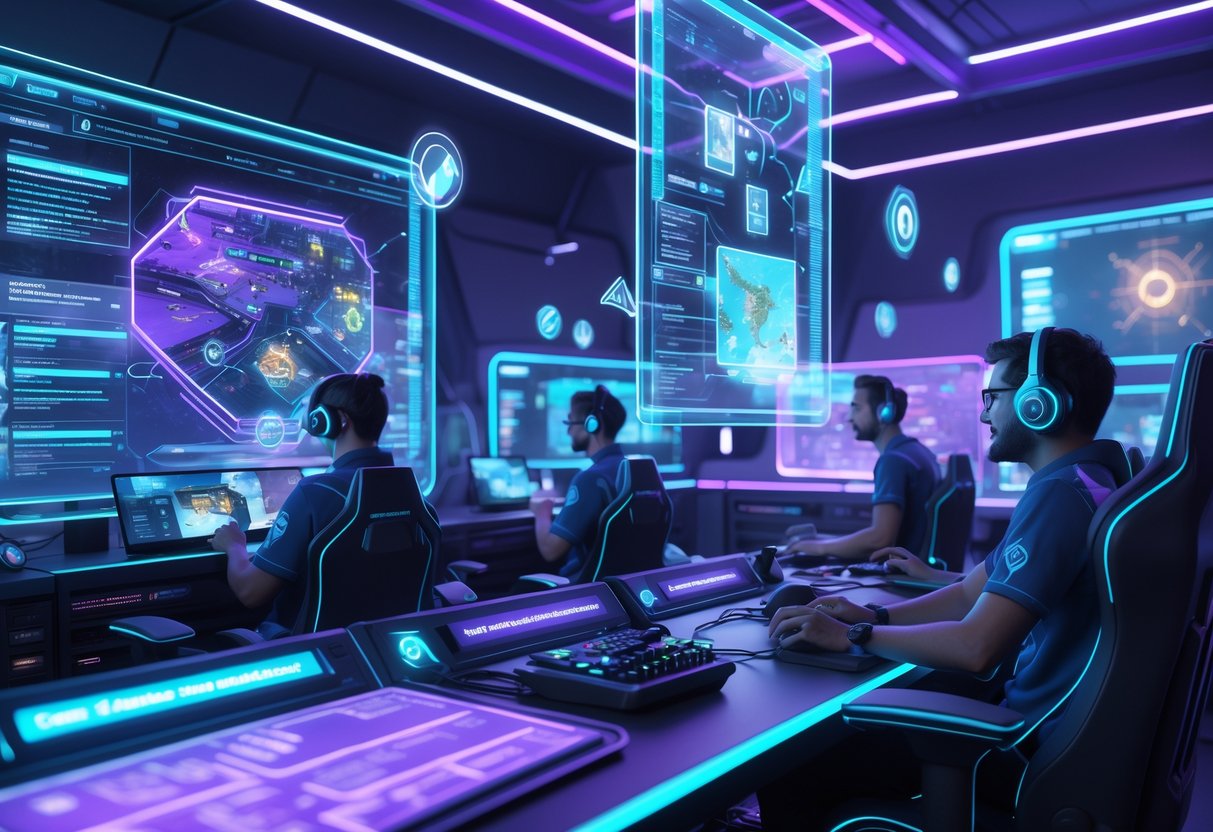
ChatGPT changes how esports teams coordinate in matches and work together outside of games. The AI helps teams make quicker tactical calls and builds stronger communication that leads to better results.
Coordinating In-Game Tactics
Real-time tactical coordination is what separates good teams from great ones. ChatGPT acts as an assistant, analyzing the game and suggesting plays in seconds.
During matches, captains can type in the current situation and get advice. For example, in Counter-Strike, a captain might say, “We’re defending A site, low on utility, 3v4—what’s our move?” ChatGPT processes that and suggests specific positions or rotations.
Before matches, teams can use ChatGPT to simulate opponent strategies. The AI identifies enemy patterns and recommends counterplays.
A lot of pro teams now use AI tools to track what opponents like to do. ChatGPT analyzes these habits and builds quick-reference guides for each player’s role.
Quick tactical callouts get better with ChatGPT’s help. The AI suggests clearer, more precise calls, cutting down confusion when things get hectic.
Improving Team Collaboration
Good teamwork isn’t just about the game—it’s in the planning and reviews too. ChatGPT makes organizing, analyzing, and building team chemistry easier.
Practice sessions get more efficient with AI. ChatGPT creates training schedules, suggests drills, and tracks which skills each player needs to work on.
Teams usually struggle with post-match analysis. ChatGPT processes descriptions of what happened and points out moments worth reviewing. It organizes feedback so we know what worked and what needs fixing.
Conflict resolution benefits from ChatGPT’s neutral take. If teammates disagree, the AI can lay out the facts and suggest fair compromises.
For remote teams, ChatGPT helps plan practices across time zones and keeps everyone on the same page.
Some semi-pro teams say AI tools have cut down on drama and boosted team chemistry. That’s led to better results at tournaments.
Improving Player Engagement Through AI
AI is changing how games keep us hooked. It adapts to how we play and encourages us to think creatively.
ChatGPT, in particular, helps craft gaming experiences that feel new and challenging every time.
Adaptive Difficulty and Personalised Challenges
AI-powered games notice how we play and tweak the difficulty on the fly. No more hitting a wall where things get impossibly tough—or slogging through mind-numbing easy parts.
How AI adapts to our play style:
- It watches our reaction times and the choices we make.
- Enemies shift their behaviour to match our skills.
If we’re struggling or breezing through, AI can change up puzzle difficulty. That’s pretty handy, honestly.
ChatGPT actually pushes this even further by whipping up custom challenges for specific games. We can just ask it to design training drills for whatever part of our gameplay needs work.
Example challenges ChatGPT can create:
- FPS aim training routines
- Strategy game build order practice
- Fighting game combo sequences
Players say AI-driven difficulty keeps them hooked way longer than old-school fixed-difficulty games. It just feels more personal when the game meets us at our level.
Fostering Creativity With ChatGPT Prompts
ChatGPT can really spark new ideas when we hit creative blocks in games. Whether we’re building something wild in a sandbox or plotting a new strategy, AI can toss out fresh suggestions.
Creative gaming applications:
- Comes up with unique base designs for building games.
- Invents character backstories for RPGs.
It’ll even suggest weird, unconventional strategies for competitive play. Sometimes those actually work.
We get better results if we’re specific. Instead of a vague “help me build something,” we might say, “create a medieval castle design for Minecraft that uses redstone defences.”
Quick win: Try telling ChatGPT to mash up two game mechanics you’ve never seen together. Oddly enough, you’ll often get some cool gameplay ideas.
Being clear about what we want matters. ChatGPT just works better with constraints and goals than with open-ended, “do whatever” requests.
ChatGPT in Game Design and Development
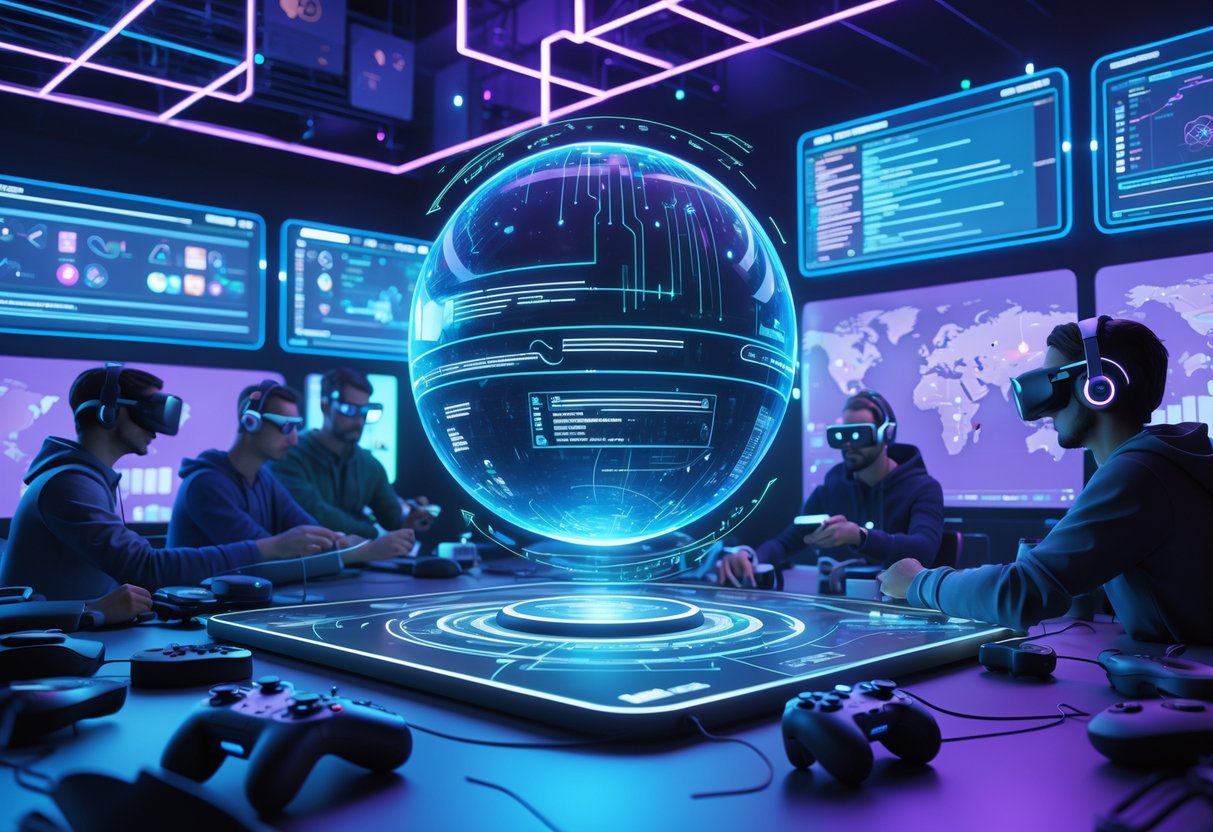
ChatGPT is shaking up how developers build games. It handles tricky design work, generates creative assets, and even automates dialogue.
The AI jumps in from the first concept all the way to polished dialogue systems.
Assisting Game Designers
Game designers pull in ChatGPT as a creative sidekick throughout development. The AI digs through design docs and whips up templates for new projects.
Key design assistance areas:
- Concept development: It pitches initial game ideas and mechanics.
- Documentation: It writes up game design docs and technical specs.
It also helps with research—analyzing trends and what players seem to want.
When designers hit a wall, ChatGPT suggests ways around design challenges. New folks in the industry especially appreciate how it breaks down game theory and industry standards into bite-sized info.
ChatGPT can compare similar games and help spot what makes your project stand out.
It’s also great for keeping teams organized. The AI creates checklists for every phase and tracks milestones.
Generating Creative Content
ChatGPT spits out creative assets that speed up development. It can handle everything from character backgrounds to world-building details.
Content generation capabilities:
- Character creation: Names, backstories, personality quirks, motivations.
- World-building: Places, histories, cultures, and all those little environmental touches.
It also helps with mechanics—rules, systems, and balancing tips.
For quests, it comes up with objectives, rewards, and progression paths.
During brainstorming, ChatGPT throws out tons of variations when designers get stuck. It even makes placeholder content so teams can visualize the final product while they work on the basics.
Indie devs love it because it’s like having a creative consultant—without the high cost.
Dialogue and Storytelling Automation
Games today need a ton of dialogue and branching stories. ChatGPT automates much of this content without dropping the quality.
Narrative automation features:
- Dynamic dialogue: Characters talk back and forth, adapting to what the player does.
- Branching storylines: Multiple plot paths, all with real consequences.
It keeps character voices consistent, even across giant dialogue trees. The AI tracks how choices change the story, mapping out all the possible endings.
In multiplayer games, ChatGPT can generate responses for AI-controlled characters, making the world feel more alive.
It also localizes dialogue for different regions, tweaking tone and references while keeping the story intact.
Gaming Platforms and AI Integration
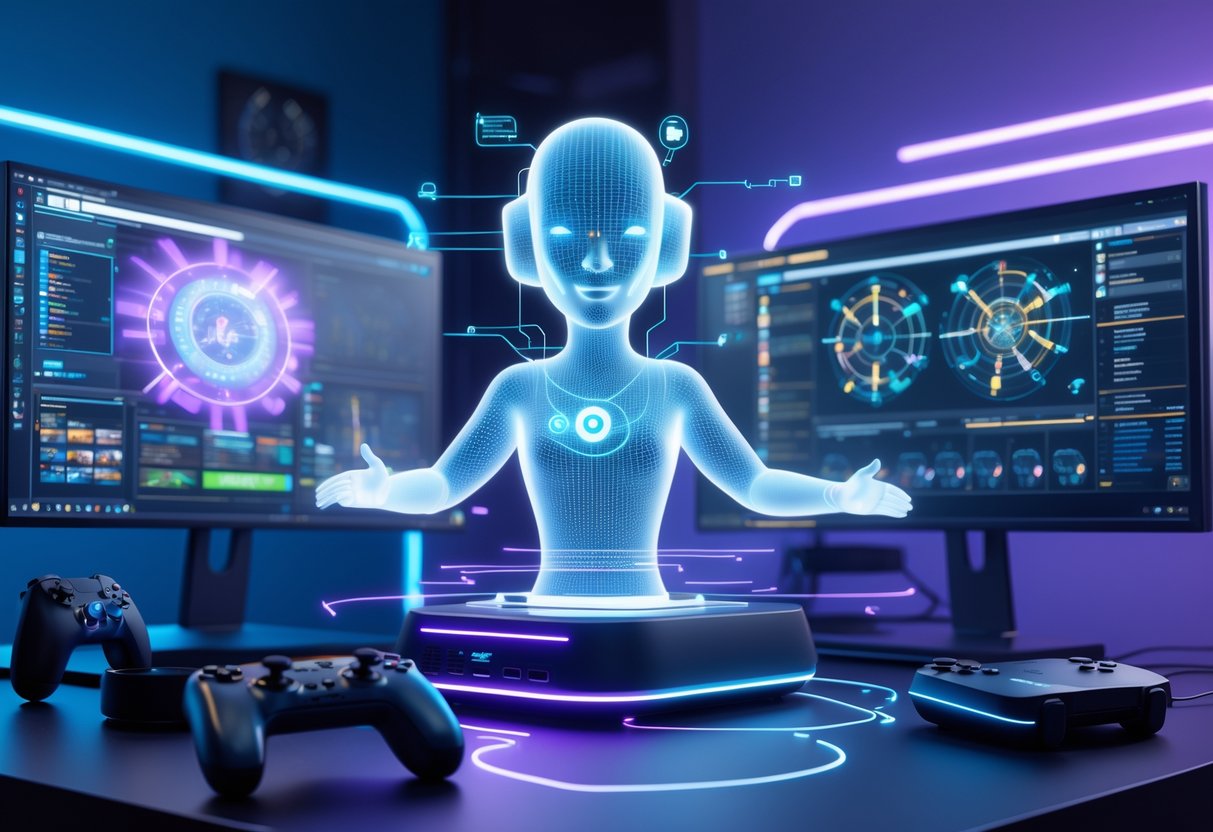
Gaming consoles, PCs, and mobile devices are all jumping on the AI bandwagon. ChatGPT and similar tech are making NPCs smarter and gameplay more responsive across the board.
Console and PC Implementations
Major consoles and PC platforms now bake AI right into the system. PlayStation and Xbox support games with ChatGPT-powered NPCs that answer questions naturally and change how they act depending on what we say.
PC gaming is leading the charge. Steam Workshop already has games with AI-driven dialogue. Some popular titles use ChatGPT APIs for dynamic quests and personalized stories.
Real-time strategy games get a big boost from this. Players can ask their AI assistant about build orders or counter-strategies without pausing to look it up.
You’ll need:
- An internet connection for API calls.
- At least 1GB extra RAM for local AI.
- Updated graphics drivers that can handle AI acceleration.
Heads up: On consoles, responses can lag by 2-3 seconds because of processing limits.
Expanding to Mobile Gaming
Mobile games use ChatGPT a bit differently. iOS and Android titles often plug in AI for in-game tutorials and adaptive difficulty instead of deep dialogue.
Some mobile RPGs now have AI companions that learn how you play. They track your choices and suggest builds or gear through natural chats.
Battery drain is still a pain point. AI-powered mobile games chew through 20-30% more battery than regular ones. To fix this, a lot of devs process AI requests on servers instead of on the device.
Key features on mobile:
- Voice commands for strategy games.
- Personalized daily challenges made by AI.
Smart matchmaking now considers how you like to play.
Most mobile games give basic AI features for free, but premium subscriptions unlock the good stuff. Expect to pay £3-8 a month for the full AI experience.
Ethical Considerations of Using ChatGPT in Gaming
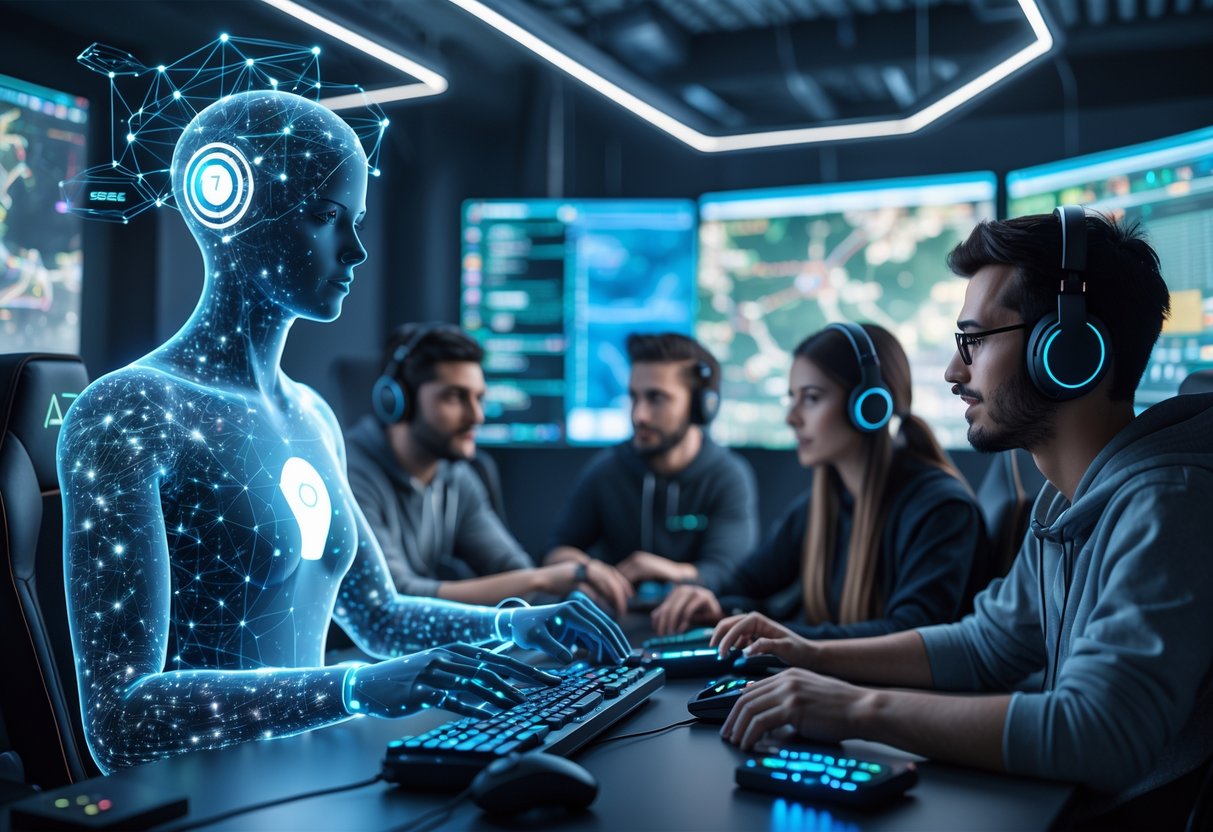
When we use AI tools like ChatGPT for gaming strategies, we have to think about fairness and keeping competitive gaming honest. These questions shape how we use AI responsibly.
AI Fairness and Transparency
The gaming industry faces tough questions about AI creating unfair advantages between players. If some gamers use ChatGPT for tips and others don’t, is that fair?
We need to ask whether AI-generated strategies give players too much of a leg up. Esports tournaments increasingly set rules about AI assistance during matches.
Transparency matters when players use AI to prep. More communities now require folks to say when AI helped make guides or training content. This keeps things honest about where strategies come from.
Ownership is another sticky point. Since ChatGPT learns from content made by real players, how original is the stuff it spits out?
Key fairness principles:
- Everyone should have access to AI tools, no matter their skill.
- Clear guidelines about when AI help is okay.
- Label AI-generated content so players know what’s what.
- Protect human creativity and expertise.
Preventing Cheating and Exploits
Gaming communities worry ChatGPT could fuel new kinds of cheating. Real-time AI help during matches? That’s crossing a line.
Some people have tried using AI for automated gameplay or finding exploits. That goes against the whole idea that winning should come from skill and decisions—not bots.
Tournament organizers now watch more closely for AI-assisted play. Most competitions ban AI tools during matches, though they’re fine for practice.
It’s tricky to tell the difference between legit research and unfair advantages. Using ChatGPT to learn game mechanics is one thing—using it live in a match is another.
Prevention strategies:
- Set clear tournament rules about AI use.
- Build detection systems for automated help.
- Teach players about ethical AI use.
- Let the community report suspicious stuff.
Human skill and creativity need to stay at the heart of gaming, even as AI gets smarter.
Understanding Game Monetisation with AI

AI is changing how games make money by analyzing player data to fine-tune in-game purchases and microtransactions. Smart algorithms help developers price things fairly while still maximizing revenue with personalized offers.
Advice on In-Game Purchases
AI helps create better in-game purchase strategies for both players and devs. Machine learning checks out how players behave to figure out the best times to offer purchases and which items different people want.
Behaviour analysis shows when players are most likely to spend—usually after tough levels or during big matches.
Dynamic pricing lets item costs shift based on how engaged or experienced someone is. New players might get cheaper starter packs, while veterans see fancy cosmetics.
Personalized recommendations mean players who love customizing characters get shown skins, while competitive types see performance upgrades.
Here’s how AI times those offers:
- After achievements: Offer upgrades when players feel good.
- During challenges: Suggest helpful items when players struggle.
It also pushes special deals during social play or seasonal events.
Handling Microtransactions Responsibly
AI can make microtransactions more ethical by watching spending habits and stopping harmful behavior. Smart systems suggest breaks if someone spends too much or even pause purchase options for players at risk.
Value transparency is key—AI-powered stores show exactly what you’re getting, how long it lasts, and what it costs before you buy.
Fair progression keeps the game fun for free players, too. AI watches to make sure paying doesn’t break the balance.
Warning systems help players stay in control:
- Daily spending caps with cool-downs.
- Monthly budget tracking and summaries.
There are also age-based limits and parental controls for families.
Industry leaders say that sustainable monetisation is about building long-term player relationships—not just chasing quick cash.
Boosting Problem-Solving Skills and Learning
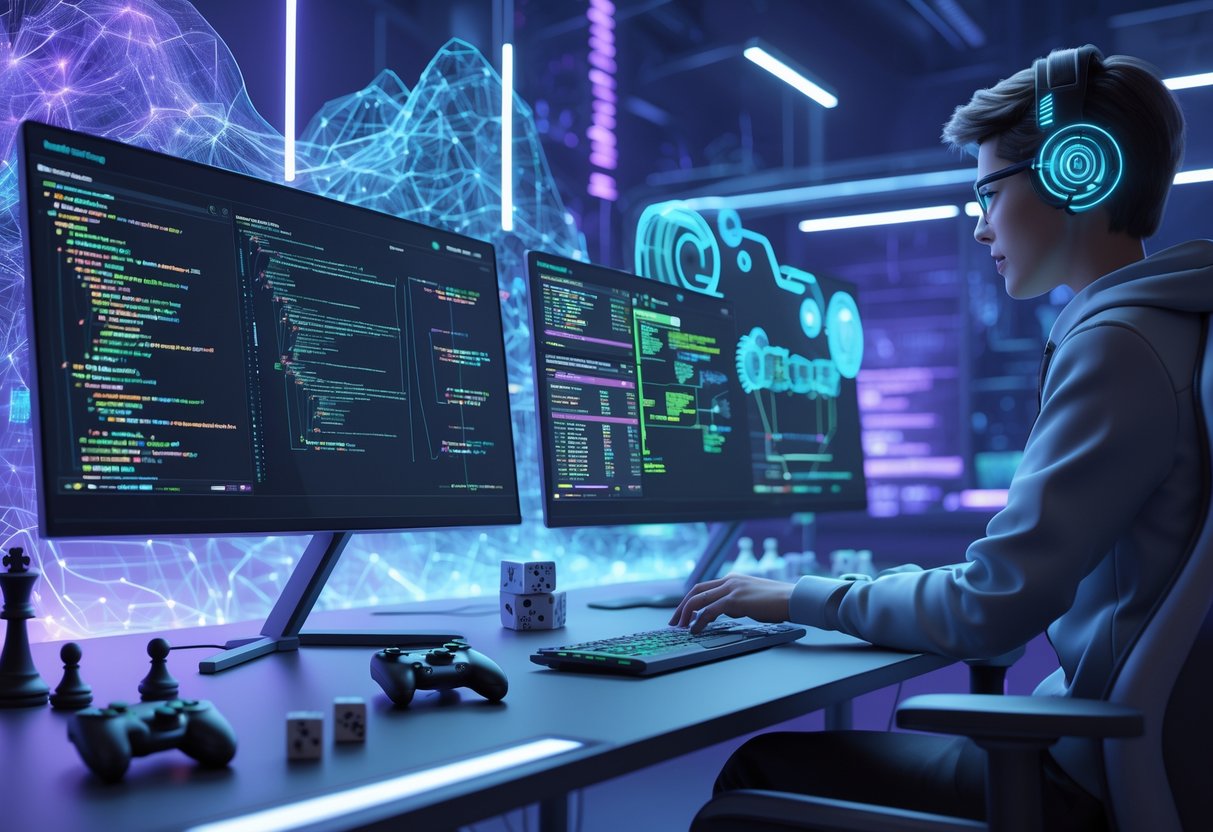
Gaming with ChatGPT really changes how we build critical thinking skills. Interactive challenges and personalized feedback help us get better at problem-solving and spark creative thinking.
Research points to AI-powered gaming as a direct way to improve these abilities.
Gamified Learning Experiences
ChatGPT can whip up personalized gaming challenges that match our skill level. Just ask it to design puzzle scenarios, create branching storylines, or throw together strategic problems based on your favorite video games.
It reacts right away to our choices and explains why some tactics work better than others. That instant feedback makes it easier to grasp tricky gaming concepts—no need to wait around for a human tutor.
Quick win: Try asking ChatGPT for a 5-minute strategy puzzle based on your current game. If you practice daily, you’ll start spotting patterns faster.
Lots of gamers now use ChatGPT to simulate tough scenarios before jumping into actual matches. We get to practice making decisions in a low-stakes environment.
ChatGPT keeps tabs on our progress and nudges us toward harder challenges as we improve. That kind of systematic approach builds problem-solving skills way more effectively than just random practice.
Gaming educators have noticed that students using ChatGPT get better at logical reasoning. The personalized touch keeps us engaged longer than the usual learning methods.
Developing Critical Thinking via AI
ChatGPT pushes us to question our gaming habits by suggesting strategies we might not have thought about. When we explain our moves, it spots weak points in our logic.
We get better at problem-solving when we debate tactics with ChatGPT. It fires back with counter-arguments, so we have to back up our choices with real evidence instead of just gut feelings.
Warning: Don’t lean on AI suggestions too much during real matches. Use ChatGPT for practice, then rely on your own skills when it counts.
We can break down past gaming mistakes by describing what happened to ChatGPT. It helps us figure out what went wrong and points out specific ways to improve next time.
Gaming coach Aaron Connolly says players using AI tools tend to develop stronger analytical thinking. They start questioning their first instincts and look for more than one solution before making a move.
One of the biggest perks is learning how to explain our thought process clearly. ChatGPT makes us spell out our reasoning, which sharpens our decision-making across all sorts of game genres.
The Future of ChatGPT and AI in Gaming
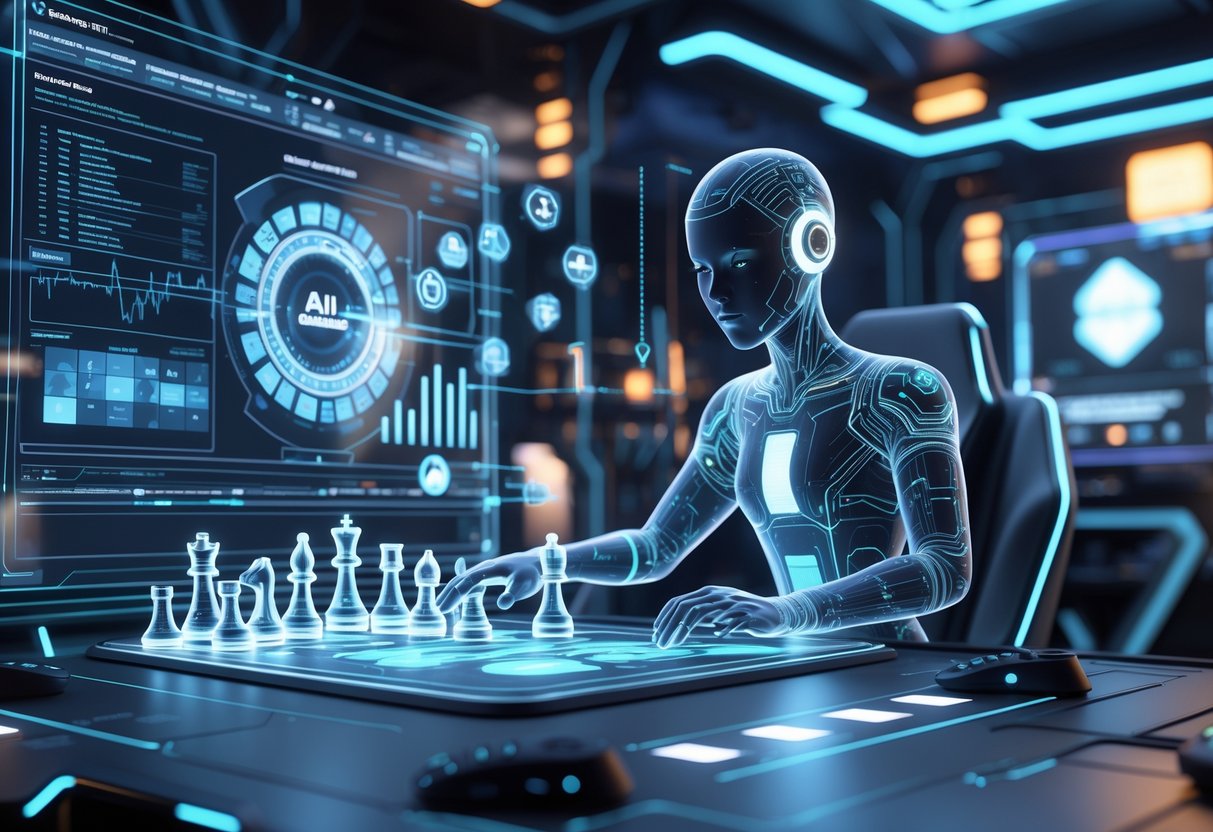
AI technology in gaming is moving fast. We’re seeing new breakthroughs in strategic help and creative tools that could totally change how players approach competitive games.
Trends in AI-Driven Strategies
Right now, a few big trends are popping up in AI-powered gaming. Real-time coaching is getting smarter, with AI giving instant feedback right in the middle of matches—no more waiting until it’s over.
Personalized training programs are also a big deal. AI can track your play style over time, spot your weak points, and build custom practice routines just for you.
Adaptive difficulty systems are shaking up how we get better at games. These systems change the challenge based on your current skills and how quickly you’re learning.
Voice-activated strategy assistants are on the rise too. Players can ask for advice mid-game without needing to pause and type. It keeps your head in the game while still getting tactical tips.
Multi-game analysis is another cool development. AI can compare your performance across different games and help you spot skills that carry over.
Now, with streaming platforms, AI can break down footage from pro players. It turns their top-level tactics into practical advice that regular players can actually use.
Opportunities for Further Innovation
We’re probably going to see big jumps in predictive analytics for competitive gaming. AI might soon predict what your opponents will do, even with just a little gameplay data.
Dynamic meta-game tracking could be huge. AI could keep an eye on new strategies popping up across the community and suggest counters on the fly.
Cross-platform integration looks set to grow. Imagine getting strategy advice that works on mobile, PC, and console versions of your favorite game.
Educational partnerships could really shake up esports training. AI tutors might team up with human coaches to offer round-the-clock guidance.
Community-driven AI learning sounds promising. Systems that learn from thousands of players at once might spot the next big strategy before it goes mainstream.
Blending virtual reality with AI coaching could make for some wild training sessions. Players could practice against AI-generated opponents in super immersive environments.
We might even see smart tournament prep tools. These could analyze your next opponents and suggest counter-strategies based on how they’ve played in the past.
Frequently Asked Questions
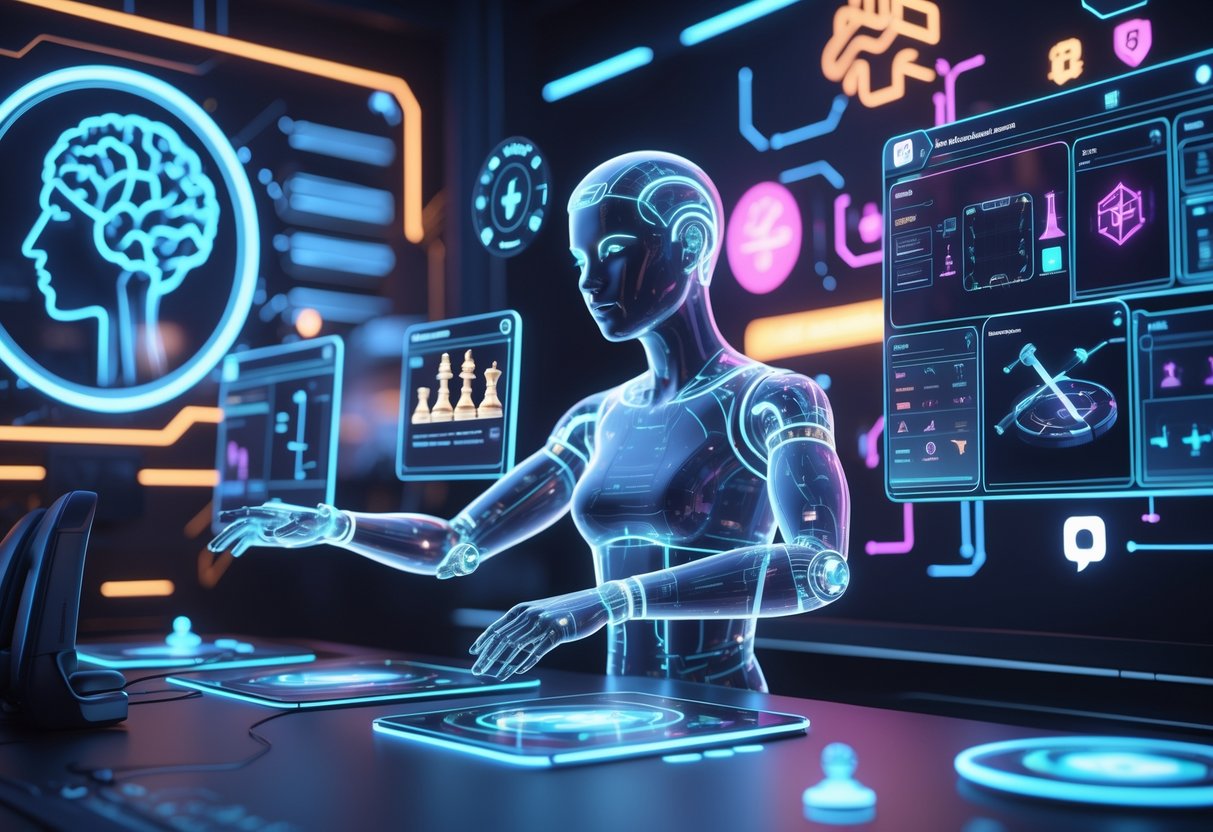
Here are answers to some of the most common questions competitive gamers ask about winning strategies. We’ll dig into decision-making, tactical approaches, team building, and practical learning resources.
What’s the best way to improve my decision-making skills in strategy games?
Try slowing down your thinking during non-competitive matches. A lot of players rush decisions under pressure and never figure out why some choices work better.
Record your gameplay and watch it back later. Find moments where you had several options and think through which one would’ve worked best.
Practice the “pause and consider” trick. Before making a big move, quickly list three possible actions and what you think will happen with each.
Watch pro players’ decision trees. Tournament streams with commentary can show you how the best weigh their options in real time.
Set up custom scenarios in practice mode. Many strategy games let you create specific situations so you can practice decision-making without the stress of a full match.
Can you suggest some effective tactics for real-time strategy games?
Start with economic basics. Most newer players lose because they can’t keep resources flowing, not because they mess up in fights.
Try the “harass and retreat” move. Send small groups to mess with your opponent’s economy while your main army gets stronger.
Learn unit counters before anything fancy. Every RTS has some kind of rock-paper-scissors mechanic that’s more important than complicated strategies.
Go for “expand behind aggression.” While you’re attacking, sneakily build up your base for a long-term edge.
Grab key map spots early. High ground, resource points, and chokepoints usually decide matches more than what units you have.
Practice micro-management in small battles. Custom matches focused on tiny skirmishes help you sharpen your control.
How do I create a balanced team or character build for competitive play?
Start with meta builds from pro tournaments. They work because they’ve survived the toughest tests.
Stick to the role distribution rule. The best teams have the right mix of damage, support, and defense.
Think synergy, not just raw power. Teams with abilities that work together usually beat groups of individually strong characters.
Test your build against common counters. If a few popular strategies can crush your setup, it’s time to tweak things.
Plan for different game phases. Early, mid, and late game often call for different team setups.
Quick win: Use character or team builder tools for your game. They’ll show you stats and synergy ratings at a glance.
What are the top resources for learning advanced gameplay mechanics?
Pro tournament VODs (Video on Demand) are gold for strategy. Twitch and YouTube have full archives with expert commentary.
Game-specific coaching sites offer structured lessons. Places like GamerzClass and ProGuides feature courses by ex-pros.
Reddit and game forums often have the latest strategies before they hit mainstream guides.
Discord communities for your game connect you to experienced players who’ll answer questions and give feedback.
Training software and aim trainers help with mechanics. Tools like Kovaak’s FPS Aim Trainer let you track your improvement.
Warning: Skip generic “gaming improvement” courses that aren’t tailored to your game. Mechanics differ too much for one-size-fits-all advice to work.
How can I master the art of resource management in complex game environments?
Set up automated systems early. Most competitive games reward players who lock in steady resource generation before fighting starts.
Learn about “resource priority windows.” Each phase of the game needs a different resource focus—economy early, military mid-game, tech late.
Balance “banking vs spending.” Hoarding resources is wasteful, but blowing it all at once can leave you exposed.
Watch how pro players allocate resources. Notice how they split resources between immediate needs and long-term growth.
Try using spreadsheets or apps to track your efficiency during practice. Compare your resource-per-minute numbers to top benchmarks.
Master resource denial. Cutting off your opponent’s resources can matter more than maximizing your own.
What methods can I use to analyse and counter my opponents’ strategies?
Try keeping a strategy journal where you jot down the patterns you notice from your opponents. Players at each skill level usually stick to some predictable moves, so you can get ready with counters ahead of time.
Start looking for early game tells. Those small choices in the first minutes often give away what your opponent wants to do later.
Go for build orders that let you adapt on the fly. Sticking to just one plan rarely works if your opponent throws something weird at you.
Watch your own replays, especially the games you lose. Sure, winning feels great, but your losses show you exactly where things fell apart.
Make scouting a habit, not just a random check-in. Try to gather info on your opponent at set points in the game.
Draw up some simple counter-strategy flowcharts for the most common things you face. Having a response ready can save you a lot of brainpower when things get hectic.

